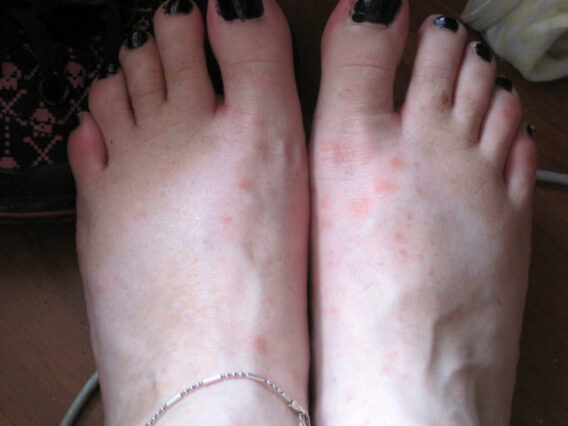 I wear 2 toe rings all year round. (One on the 2nd toe of each foot.)
I wear 2 toe rings all year round. (One on the 2nd toe of each foot.)
Personally, with gold rings (not electroplated gold though), I don’t really care what the karat weight is whenever I’m buying toe rings or other jewelry for myself.
I’ve worn toe rings (and regular rings) of all different karats and they all wear just the same and last just about the same, in my opinion.
However, some people (such as my mom) have allergic reactions to some gold pieces but not others.
Usually, the lower the karats (10k, 14k), the greater the reaction from the components (like nickel) that are combined with the gold.
In my mom’s case, her finger turns black underneath the band — but only when she’s wearing 10 karat gold rings and she’s stressed. Other gold rings do not trigger a gold allergy for her.
For jewelry to be advertised as gold in the U.S., it must be at least 40% pure, which is classified as 10-karat gold. This is the strongest quality for gold jewelry and is also the most affordable. Source
Gold Karat Explained
To clarify the various gold karat ratings, here’s a rundown:
- 24k is pure solid gold, which means that it’s also the softest and least durable.
- 18k is about 75% pure gold and 25% alloy, therefore it is a bit stronger.
- 14k is lightly over 50% pure gold and just under 50% alloy. As a result, it is very strong and a very popular choice for jewelry.
- 10k is 40% pure gold and 60% alloy and is the strongest gold available in the U.S. It is also the most affordable.
Pure gold is too soft for ordinary use and is hardened by alloying with silver, copper, and other metals … When selling it in the form of jewelry, gold is measured in karats (k), with pure gold being 24k. However, it is more commonly sold in lower measurements of 22k, 18k, and 14k. A lower "k" indicates a higher percent of copper or silver mixed into the alloy, with copper being the more commonly used metal between the two. 14-karat gold-copper alloy will be nearly identical in color to certain bronze alloys, and both may be used to produce police and other badges. 18-karat gold with a high copper content is found in some antique jewelry and will have a distinct, though not dominant copper cast, giving an attractively warm color. A similar karat weight when alloyed with silvery metals will appear less warm in color, and some low karat white metal alloys may be sold as "white gold", silvery in appearance with a sightly yellow cast but far more resistant to corrosion than silver or sterling silver. Karat weights of 20 and higher are more common in modern jewelry. Source




